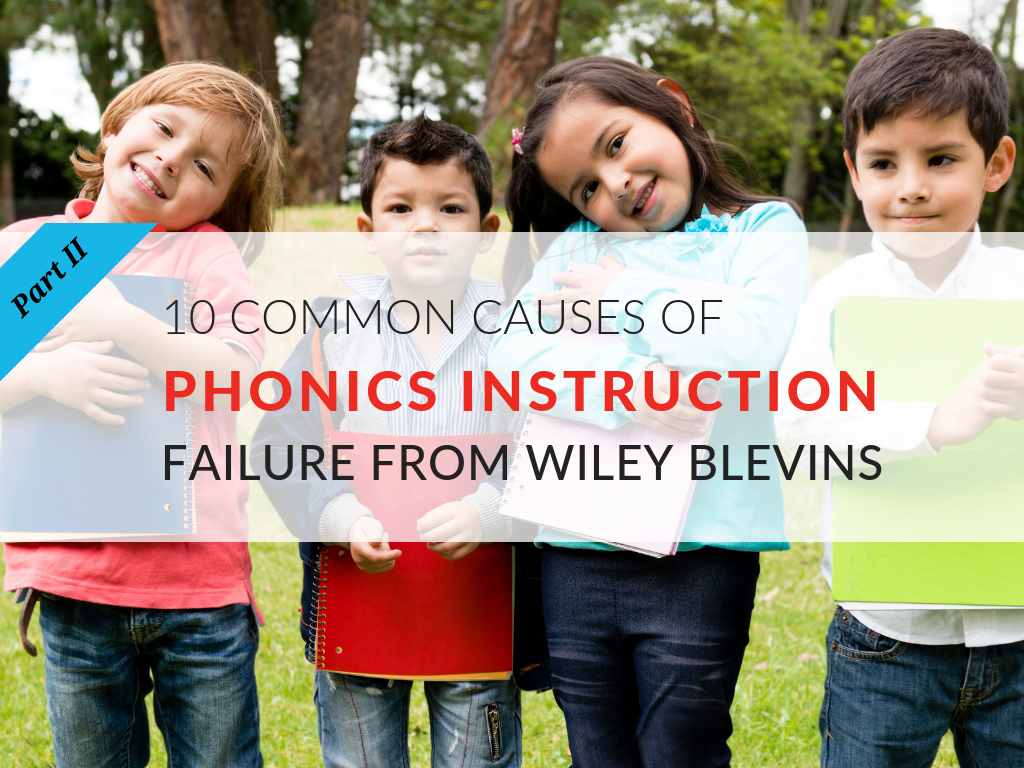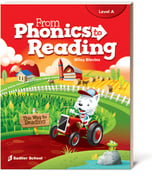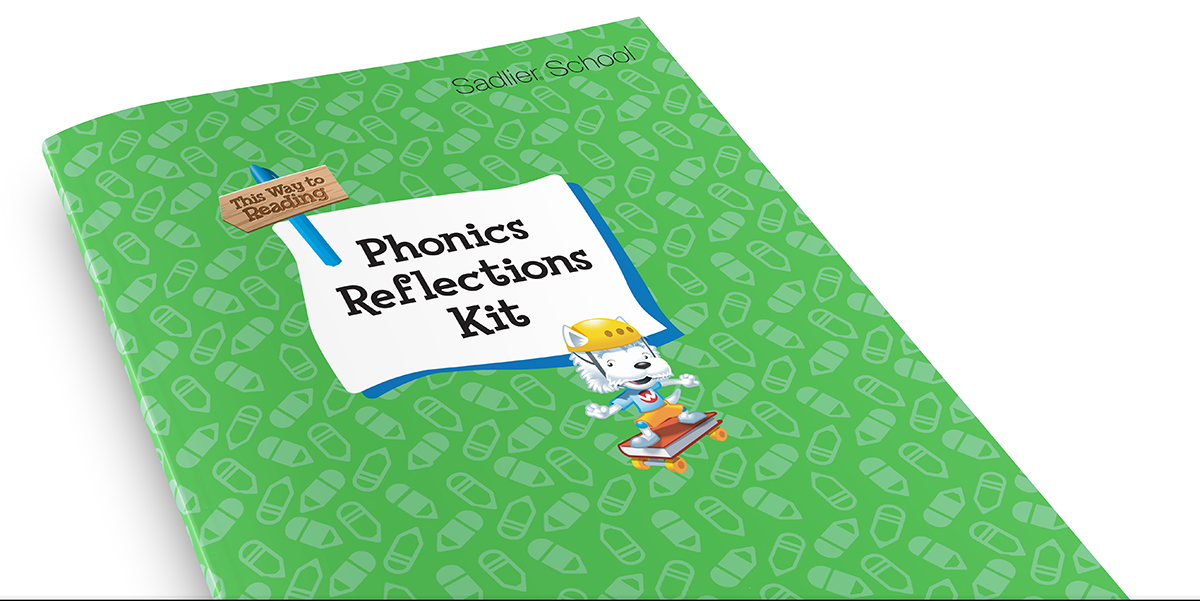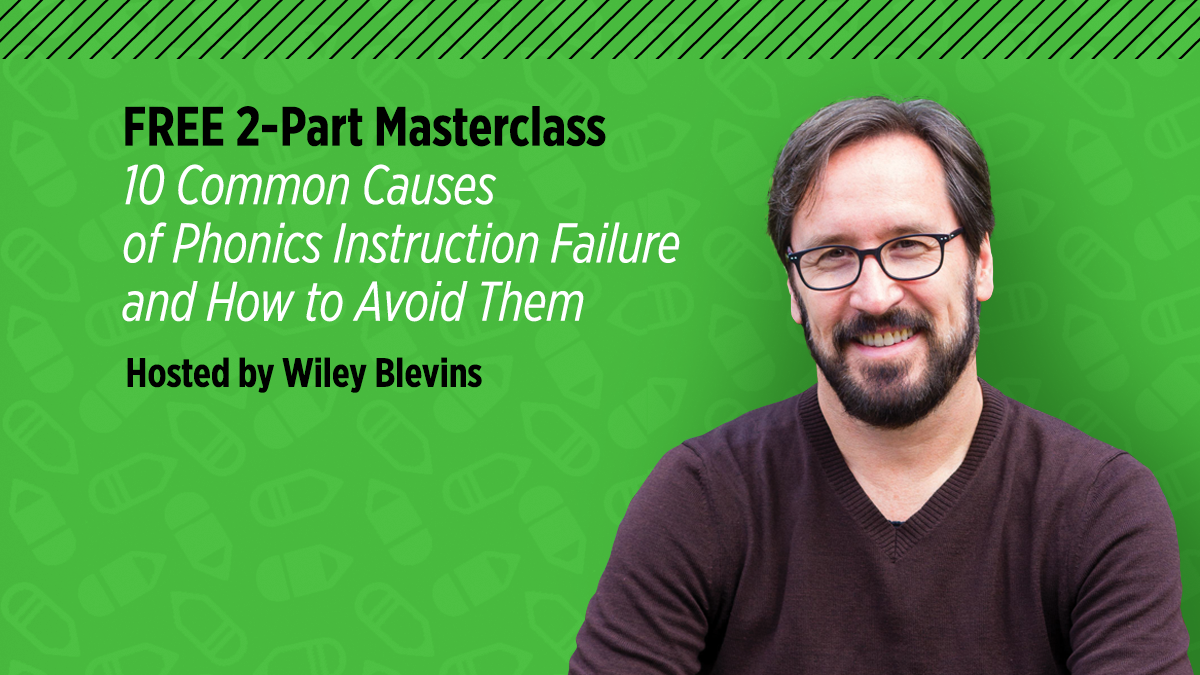May 6, 2019 ELA PD - Literacy, ELA K-5, ELA Focus - Reading, ELA PD - Leadership
My Take-Aways from Wiley Blevins’s 10 Common Causes of Phonics Instruction Failure, Part II
By: Emily Niska
After attending Wiley Blevins’s Two-Part Phonics Masterclass: 10 Common Causes of Phonics Instruction Failure and How to Avoid Them, I’m rip-roaring and ready to go in terms of changing the way I approach both my phonics and instruction and materials! In order to drastically improve student learning outcomes, it is essential that we turn a critical eye to our own phonics curriculum. In this article, you’ll discover what I learned about Wiley Blevins’s last five common causes of phonics instruction failure. To learn the first 5 common causes of phonics instruction failure, read Part I.

Wiley Blevins’s Last Five Common Causes of Phonics Instruction Failure
#6 Limited Teacher Knowledge of Research-Based Phonics Routines and Linguistics
If you’ve ever taught ELA in two different grade levels, then you can relate to how vastly different the phonics skills are across grade bands. Phonics work requires a certain level of linguistic expertise, and when teachers shift from one grade level to the next, they don’t always get the training they need to teach research-based phonics lessons and routines.
In order to ensure that all teachers have the knowledge necessary for teaching research-based grade-appropriate phonics, teachers and administrators need to take steps to educate or refresh their knowledge.
Blevins offers the following solutions.
- If possible, teachers should teach within the same grade band.
- If teachers must move across grade bands, administrators should ensure that they have the training necessary to refresh them in the nuisances of phonics instruction at those different grade levels.
- Teachers and administrators should take advantage of the knowledge of the speech therapist and involve them in trainings, assessments, and progress monitoring.
Download a Phonics Reflections Kit now!
#7 Inappropriate Pacing of Lessons
Although we touched on this a bit in my previous post, it’s important to reexamine the amount of time we’re spending on each activity in our phonics lessons. All teachers have been guilty at one time or another of spending too much time on the parts of the lessons we enjoy.
Blevins emphasizes that teachers need to examine their weekly schedules and fine-tune them to ensure that they’re really spending the bulk of their instructional minutes on what he calls, “power skills.”
He goes on to note that we must, then, focus our time on the activities that really move the needle in terms of student learning. Those activities include
- Blending
- Word Building and Word Sorts
- Dictation
- Reading Decodable Text
#8 No Comprehensive or Cumulative Mastery Assessment Tools
Sometimes our phonics instruction fails because we simply don’t have the correct tools. A sound phonics curriculum MUST include comprehensive and mastery assessments, so that we know
- What skills our students come to us with at the beginning of the year
- Where they have skill deficits due to learning decay
- When they have mastered a skill an can move on to another
Take a moment to think about your current phonics assessments. Are you giving simple, light assessments at the end of each week and then moving on? If so, it’s time for a new set of assessments, ones that tell you if a student has really mastered the ability to apply their skills to new situations.
If your assessments are ineffective, then check out these suggestions from Blevins.
- Have a “no-assumption instruction” model. Don’t assume your students come to you with a perfect knowledge record.
- Use a Comprehensive Phonics Assessment to find their learning deficits and fill them in.
- Use a Cumulative Mastery Assessment Tool that monitors BOTH accuracy and speed
 Don’t have access to a great Comprehensive Phonics Assessment or Cumulative Mastery Assessment? Check out Wiley Blevins’s new program, From Phonics to Reading, which has these assessments built in to the weekly lessons.
Don’t have access to a great Comprehensive Phonics Assessment or Cumulative Mastery Assessment? Check out Wiley Blevins’s new program, From Phonics to Reading, which has these assessments built in to the weekly lessons.
#9 Transitioning to Multisyllabic Words Too Late
Anyone who has taught Grade 2 knows that it’s a “make it or break it” kind of year in terms of phonics skills. So many kids who are doing really well in Kindergarten and Grade 1 get to Grade 2 and simply fall apart. Why? What happens between Grades 1 and 2 that makes all the difference?
According to Wiley Blevins, it’s simple: they haven’t had enough exposure to multi-syllabic words!
We all know from point #3 above that decodable texts must allow students to directly apply only the phonics skills they have learned, in order to boost their confidence and their reading enjoyment. In Grade 2, everything changes. Kids are faced with texts that are littered with longer, more complex words, yet many of them haven’t had lessons in how to decode them. Thus, their confidence decreases along with their love of reading.
That’s why it is so important to get students ready to face their increasingly complex reading needs by introducing them to multi-syllabic words at a younger age. Blevins suggests that we start by
- introducing them to the six syllable spelling patterns (closed, open, vowel-silent e, vowel team, r-controlled, consonant + ie) before Grade 2
- ensuring that we are flexible about how we teach children to attack multi-syllabic words
- connecting word building with syllable cards to daily reading
#10 Overdoing It (Especially Isolated Skill Work)
As we all know by now (I hope!), it’s incredibly important to work on phonemic awareness and letter recognition, to ensure that students have the decoding skills necessary for strong reading fluency. But as important as phonics is, we don’t want our kids to experience chronic burnout!
If you’re spending way too much time on isolated skill work, it’s time to readjust the way you’re allotting your instructional time, so that you’re equally teaching two other vitally important skills.
- Vocabulary
- Background knowledge
Vocabulary and background knowledge are huge if we want to (as Blevins puts it) plant “the seeds of comprehension.” So, if you’re sitting there staring at your wide-eyed little kindergarteners and struggling with how to elevate your vocabulary conversation, try this strategy.
- Before reading the story for the day, have a talk with your students during which you sprinkle in a vocabulary word over and over again, so they have the background knowledge necessary to decode it later on.
Conclusion
Doing what’s best for our students means giving them the tools they need to be independent, fluent readers. With that goal in mind, we must examine our phonics instruction failures and (with Wiley Blevins’s help) find ways to correct them.
If you want to hear more about the most frequent phonics pitfalls from the expert himself, sign up for the on-demand masterclass, 10 Common Causes of Phonics Instruction Failure and How to Avoid Them, by clicking below.





